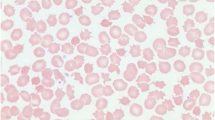Summary
A new apolipoprotein A1 (APOA1) gene variant has been identified in a family ascertained through a proband undergoing coronary angiography. The variant, ApoA1 Baltimore, was due to a mutation at codon 34 of the third exon of the APOA1 gene (CGA to CTA) that resulted in an arginine-to-leucine substitution at the tenth amino acid of the mature ApoA1 and a change in charge of -1. The mutation abolishes a TaqI restriction site and it is easily detectable after polymerase chain reaction amplification of genomic DNA. The proband was heterozygous for the mutation. Eight other members of the pedigree had the same ApoA1 variant. Cosegregation of the variant with hypoalphalipoproteinemia could not be demonstrated and the association of this mutation with hypoalphalipoproteinemia was confined to three affected members of the nuclear family. No effect of the mutant on any lipoprotein phenotype could be established.
Similar content being viewed by others
References
Antonarakis SE, Oettgen P, Chalaravarti A, Halloran SL, Hudson RR, Feisse L, Karathanasis SK (1988) DNA polymorphism haplotypes of the human apolipoprotein ApoA1-ApoC3-ApoA4 gene cluster. Hum Genet 80:265–273
Bojanovski D, Gregg RE, Chiselli G, Schaefer EJ, Light JA, Brewer HB Jr (1985) Human apolipoprotein A-I isoprotein metabolism: proapoA-I conversion to mature ApoA1. J Lipid Res 26:185–193
Breslow JL (1985) Human apolipoprotein molecular biology and genetic variation. Annu Rev Biochem 54:699–727
Francheschini G, Sirzori CR, Bosisio E, Gualandri V, Orsini GB, Mogavero AM, Gapurso A (1985) Relationship of the phenotype expression of the ApoA1 Milano apoprotein with plasma lipid and lipoprotein patterns. Atherosclerosis 58:159–174
Havel RJ, Eder HA, Bragdon JH (1955) The distribution and chemical composition of ultracentrifugally separated lipoproteins in human serum. J Clin Invest 34:1345–1353
Karathanasis SK, Zannis VI, Breslow JL (1983) Isolation and characterization of the human apolipoprotein A1 gene. Proc Natl Acad Sci USA 80:6147–6151
Kunkel LM, Smith KD, Boyer SH, Borgaonkar SD, Wachtel SS, Miller OJ, Breg WR, Jones HW, Rary JM (1977) Analysis of human Y chromosome specific reiterated DNA in chromosome variants. Proc Natl Acad Sci USA 74:1245–1249
Kwiterovich PO Jr (1988) HyperapoB: a pleiotropic phenotype characterized by dense low density lipoproteins and associated with coronary artery disease. Clin Chem 34 [Suppl B-1 to B-135] B71-B83
Kwiterovich PO Jr, Sniderman AD (1983) Atherosclerosis and apoproteins B and A1. Prev Med 12:815–834
Kwiterovich PO Jr, White S, Forte T, Bachorik PS, Smith H, Sniderman D (1987) Hyperapobetalipoproteinemia in a family with familial combined hyperlipidemia and familial hypercholesterolemia. Arteriosclerosis 7:211–225
Lipid Research Clinics Population Studies Data Book (1980) The prevalence study, vol 1. (NIH publication no 80-1527) US Department of Health and Human Services, Washington, DC
Maciejko JJ, Holmes DR, Kottke BA, Zinsmeister AR, Dinh DM, Mao SJT (1983) Apolipoprotein A1 as a marker of angiographically assessed coronary artery disease. N Engl J Med 309:385–389
Manual of Laboratory Operations (1982) Lipid and lipoprotein analysis. (LRC Program, vol 1) DHEW publication no. (NIH) 75-628, May 1974 (revised October 1982)
Oettgen P, Antonarakis SE, Karathanasis SK (1986) BglII polymorphism site downstream to the human ApoA4 gene. Nucleic Acids Res 14:7138
Ordovas JM, Schaefer EJ, Salem D, Ward RH, Glueck CJ, Vergani C, Wilson PWF, Karathanasis SK (1986) Apolipoprotein A1 gene polymorphism associated with premature coronary artery disease and familial hypoalphalipoproteinemia. N Engl J Med 314:671–677
Saiki RK, Scharf S, Faloona F, Mullis KB, Horn GT, Erlich HA, Arnheim N (1986) Enzymatic amplification of beta globin genomic sequenced and restriction site analysis for diagnosis of sickle cell anemia. Science 120:1350–1354
Saiki RK, Gelfand DH, Stoffel S, Scharf SJ, Higuchi R, Horn GT, Mullis KB, Erlich HA (1988) Primer-directed enzymatic amplification of DNA with a thermostable DNA polymerase. Science 239:487–491
Saltar AK, Garnev CW, Baker HN, Sparrow JT, Jackson RL, Gotto AM, Smith LC (1975) Effect of the human plasma apolipoproteins and phosphatidylcholine acyl donor on the activity of lecithin: cholesterol acyltransferase. Biochemistry 14:3057–3062
Sanger F, Nicklen S, Coulson AR (1977) DNA sequencing with chain terminating inhibitors. Proc Natl Acad Sci USA 74:5463–5467
Schaefer JR, Gregg RE, Zech LA, Meng MS, Ronan R, Antonarakis SE, Bachorik PS, Kwiterovich PO, Brewer HB (1988)Comparison of the kinetics of metabolism of normal apolipoprotein A1 and a mutant apolipoprotein A1, ApoA1 Baltimore (abstract). Clin Res 36:545A
Scott AF, Phillips JA, Migeon BR (1979) Restriction endonuclease analysis for localization of human B and S globin genes on chromosome eleven. Proc Natl Acad Sci USA 76:4563–4565
Shoulders CC, Baralle FE (1982) Isolation of the human HDL apoprotein A1 gene. Nucleic Acids Res 10:4873–4885
Sniderman A, Shapiro S, Marpole D, Malcolm I, Skinner B, Teng B, Kwiterovich PO Jr (1980) The association of coronary atherosclerosis and hyperapobetalipoproteinemia (increased protein but normal cholesterol content in human plasma low density lipoprotein). Proc Natl Acad Sci USA 77:604–608
Sprecher DL, Taam L, Brewer HB Jr (1984) Human plasma apolipoproteins: analysis by two-dimensional gel electrophoresis. Clin Chem 30:2084–2092
Utermann G, Steinmetz A, Paetzold R, Wilk J, Feussner G, Kaffarnik H, Mueller-Eckhardt C, Seidel D, Vogelberg KH, Zimmer F (1982) Apolipoprotein A1 Marburg. Studies on two kindreds with a mutant human apolipoprotein A1. Hum Genet 61:329–337
Utermann G, Haas J, Steinmetz A, Paetzold R, Rall CA, Weisgraber KH Jr, Mahley RW (1984) Apolipoprotein A-1Giessen (Pro143→Arg): a mutant that is defective in activating lecithin: cholesterol acyltransferase. Eur J Biochem 144:325–331
Youssoufian H, Kazazian HH Jr, Phillips DG, Aronis S, Tsiftis G, Brown VA, Antonarakis SE (1986) Recurrent mutations in hemophilia A give evidence for CpG mutation hotspots. Nature 324:380–382
Zannis VI, Breslow JL (1985) Genetic mutation affecting human apolipoprotein metabolism. Adv Hum Genet 14:125–215
Author information
Authors and Affiliations
Rights and permissions
About this article
Cite this article
Ladias, J.A.A., Kwiterovich, P.O., Smith, H.H. et al. Apolipoprotein A1 Baltimore (Arg10→Leu), a new ApoA1 variant. Hum Genet 84, 439–445 (1990). https://doi.org/10.1007/BF00195816
Received:
Revised:
Issue Date:
DOI: https://doi.org/10.1007/BF00195816




